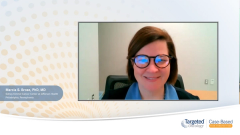
Data on Age and Randomization of Dose in Patients with RAI-R-DTC
Focusing on lenvatinib, an expert on RAI-R-DTC discusses data on real-world treatment patterns and clinical outcomes and gives an overview of papers on age and dose.
Episodes in this series

Case: A 43-Year-Old Man with RAI-R-DTC
Initial presentation and initial treatment:
- A 43-year-old man presents with fatigue, neck pain and dysphagia and was diagnosed with papillary thyroid carcinoma 10 years ago
- Following a total thyroidectomy, he underwent multiple rounds of radioactive ablation therapy.
- Initial response was positive with undetectable thyroid globulin levels and negative imaging
- PMH: Hyperlipidemia; Hypertension; Diabetes (controlled with medications)
- SH: lives with his wife and 2 teenage children; non-smoker and drinks alcohol occasionally
- PE: appears fatigued with a palpable thyroid nodule in the left lobe
- Neck examination: palpable mass in the left neck, and cervical lymphadenopathy
Clinical workup
- Labs: WNL
- Neck ultrasound: Identifies a large, irregular mass in the left thyroid bed with invasion into surrounding structures.
- CT of the neck and chest revealed neck mass along with multiple pulmonary nodules, largest 2cm x 1.5cm
- TSH: Within normal limits
- Thyroglobulin levels: Markedly elevated
- Radioactive iodine scan: Confirms radioiodine refractory disease with widespread involvement of cervical lymph nodes and distant metastases.
- Needle biopsy was performed which confirmed Papillary thyroid cancer. Next-generation sequencing was negative for mutations, rearrangements
Subsequent treatment and follow-up
- Lenvatinib 24mg po qd was initiated
This is a video synopsis/summary of a Case-Based Peer Perspectives featuring Marcia S. Brose, MD, PhD.
Brose discusses recent real-world data on treatment patterns and clinical outcomes in elderly patients with radioiodine-refractory differentiated thyroid cancer (RAI-R-DTC) treated with lenvatinib monotherapy. While the results were encouraging, she expresses disappointment that many patients in the real-world setting are not treated with the recommended starting dose of 24 mg. Brose emphasizes that controlled data, rather than real-world outcomes, should inform treatment decisions, particularly because older patients have shown an overall survival benefit with lenvatinib.
Brose notes that in her experience treating hundreds of patients, the more challenging patient is sometimes the 45-year-old man, rather than the 80-year-old woman who may tolerate the 24 mg dose well. She encourages following the indicated starting dose and adjusting as needed, only decreasing the dose after maximizing blood pressure medications and interventions for adverse effects such as diarrhea. Brose cautions that excessive concern over older patients may undermine the fact that they often benefit from the full dose.
Video synopsis is AI-generated and reviewed by Targeted Oncology™ editorial staff.










































